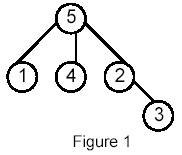poj——1470 Closest Common Ancestors
| Time Limit: 2000MS | Memory Limit: 10000K | |
| Total Submissions: 20804 | Accepted: 6608 |
Description
Input
nr_of_vertices
vertex:(nr_of_successors) successor1 successor2 ... successorn
...
where vertices are represented as integers from 1 to n ( n <= 900 ). The tree description is followed by a list of pairs of vertices, in the form:
nr_of_pairs
(u v) (x y) ...
The input file contents several data sets (at least one).
Note that white-spaces (tabs, spaces and line breaks) can be used freely in the input.
Output
For example, for the following tree:

Sample Input
5
5:(3) 1 4 2
1:(0)
4:(0)
2:(1) 3
3:(0)
6
(1 5) (1 4) (4 2)
(2 3)
(1 3) (4 3)
Sample Output
2:1 5:5
Hint
Source
#include<cstdio>
#include<vector>
#include<cstring>
#include<cstdlib>
#include<iostream>
#include<algorithm>
#define N 10100
using namespace std;
char ch;
vector<int>vec[N],que[N];
int t,s,n,m,x,y,num,qx[N],qy[N],fa[N],dad[N],ans[N],root,ans1[N];
int read()
{
,f=; char ch=getchar();
; ch=getchar();}
+ch-'; ch=getchar();}
return x*f;
}
int find(int x)
{
if(fa[x]==x) return x;
fa[x]=find(fa[x]);
return fa[x];
}
int tarjan(int x)
{
fa[x]=x;
;i<vec[x].size();i++)
if(vec[x][i]!=dad[x])
dad[vec[x][i]]=x,tarjan(vec[x][i]);
;i<que[x].size();i++)
if(dad[y=qx[que[x][i]]^qy[que[x][i]]^x])
ans1[que[x][i]]=find(y);
fa[x]=dad[x];
}
void begin()
{
;i<=n;i++)
vec[i].clear(),que[i].clear();
memset(fa,,sizeof(fa));
memset(ans,,sizeof(ans));
memset(dad,,sizeof(dad));
memset(ans1,,sizeof(ans1));
}
int main()
{
while(scanf("%d",&t)!=EOF)
{
s=t;begin();
while(t--)
{
x=read();
n=read();
;i<=n;i++)
{
y=read();fa[y]=x;
vec[x].push_back(y);
vec[y].push_back(x);
}
}
;i<=s;i++)
if(!fa[i]) root=i;
memset(fa,,sizeof(fa));
memset(ans,,sizeof(ans));
m=read();
;i<=m;i++)
{
qx[i]=read(),qy[i]=read();
que[qx[i]].push_back(i);
que[qy[i]].push_back(i);
}
tarjan(root);
;i<=m;i++)
ans[ans1[i]]++;
;i<=s;i++)
if(ans[i]) printf("%d:%d\n",i,ans[i]);
}
;
}
tarjan暴空间、、、
O(≧口≦)O气死了,蒟蒻表示以后再也不用tarjan了!!!!!!!!!!!!
#include<vector>
#include<cstdio>
#include<cstring>
#include<cstdlib>
#include<iostream>
#include<algorithm>
#define N 910
using namespace std;
vector<int>vec[N];
int n,m,s,x,y,dad[N],fa[N],top[N],deep[N],size[N],ans[N];
int read()
{
,f=; char ch=getchar();
; ch=getchar();}
+ch-'; ch=getchar();}
return x*f;
}
int lca(int x,int y)
{
for(;top[x]!=top[y];)
{
if(deep[top[x]]<deep[top[y]])
swap(x,y);
x=fa[x];
}
if(deep[x]>deep[y])
swap(x,y);
return x;
}
int dfs(int x)
{
size[x]=;
deep[x]=deep[fa[x]]+;
;i<vec[x].size();i++)
if(vec[x][i]!=fa[x])
{
fa[vec[x][i]]=x;
dfs(vec[x][i]);
size[x]+=size[vec[x][i]];
}
}
int dfs1(int x)
{
;
if(!top[x]) top[x]=x;
;i<vec[x].size();i++)
if(vec[x][i]!=fa[x]&&size[t]<size[vec[x][i]])
t=vec[x][i];
if(t) top[t]=top[x],dfs1(t);
;i<vec[x].size();i++)
if(vec[x][i]!=fa[x]&&vec[x][i]!=t)
dfs1(vec[x][i]);
}
int begin()
{
;i<=n;i++)
vec[i].clear();
memset(fa,,sizeof(fa));
memset(top,,sizeof(top));
memset(ans,,sizeof(ans));
memset(dad,,sizeof(dad));
memset(deep,,sizeof(deep));
memset(size,,sizeof(size));
}
int main()
{
while(scanf("%d",&n)!=EOF)
{
s=n;begin();
while(n--)
{
x=read();m=read();
;i<=m;i++)
{
y=read();dad[y]=x;
vec[x].push_back(y);
vec[y].push_back(x);
}
}
;i<=s;i++)
if(!dad[i])
{dfs(i);dfs1(i);break;}
m=read();
;i<=m;i++)
{
x=read(),y=read();
ans[lca(x,y)]++;
}
;i<=s;i++)
if(ans[i]) printf("%d:%d\n",i,ans[i]);
}
;
}
poj——1470 Closest Common Ancestors的更多相关文章
- POJ 1470 Closest Common Ancestors(最近公共祖先 LCA)
POJ 1470 Closest Common Ancestors(最近公共祖先 LCA) Description Write a program that takes as input a root ...
- POJ 1470 Closest Common Ancestors 【LCA】
任意门:http://poj.org/problem?id=1470 Closest Common Ancestors Time Limit: 2000MS Memory Limit: 10000 ...
- POJ 1470 Closest Common Ancestors (LCA,离线Tarjan算法)
Closest Common Ancestors Time Limit: 2000MS Memory Limit: 10000K Total Submissions: 13372 Accept ...
- POJ 1470 Closest Common Ancestors
传送门 Closest Common Ancestors Time Limit: 2000MS Memory Limit: 10000K Total Submissions: 17306 Ac ...
- POJ 1470 Closest Common Ancestors (LCA, dfs+ST在线算法)
Closest Common Ancestors Time Limit: 2000MS Memory Limit: 10000K Total Submissions: 13370 Accept ...
- poj 1470 Closest Common Ancestors LCA
题目链接:http://poj.org/problem?id=1470 Write a program that takes as input a rooted tree and a list of ...
- POJ - 1470 Closest Common Ancestors(离线Tarjan算法)
1.输出测试用例中是最近公共祖先的节点,以及这个节点作为最近公共祖先的次数. 2.最近公共祖先,离线Tarjan算法 3. /* POJ 1470 给出一颗有向树,Q个查询 输出查询结果中每个点出现次 ...
- POJ 1470 Closest Common Ancestors【近期公共祖先LCA】
版权声明:本文为博主原创文章,未经博主同意不得转载. https://blog.csdn.net/u013912596/article/details/35311489 题目链接:http://poj ...
- POJ 1470 Closest Common Ancestors【LCA Tarjan】
题目链接: http://poj.org/problem?id=1470 题意: 给定若干有向边,构成有根数,给定若干查询,求每个查询的结点的LCA出现次数. 分析: 还是很裸的tarjan的LCA. ...
随机推荐
- Python学习 Day 9 property 多重继承 Mixin
在绑定属性时,如果我们直接把属性暴露出去,虽然写起来很简单,但是,没办法检查参数,导致可以把成绩随便改: s = Student() s.score = 9999 为了限制score的范围,可以通过一 ...
- 计算机网络、OSI模型、TCP/IP族
一.计算机网络分类 1.按通信距离分类: 局域网:LAN,10m-1000m,房间.校园: 城域网:MAN,10km,城市: 广域网:WAN,100km以上,国家.全球. 二.OSI(Open Sys ...
- swift 与 @objc
Objective-C entry points https://github.com/apple/swift-evolution/blob/master/proposals/0160-objc-in ...
- python练习1 登录和三级菜单
,: username1 = input("请输入您的用户名:")# password1 = getpass.getpass("请输入您的密码:") passw ...
- CAD使用DeleteXData删除数据(com接口)
主要用到函数说明: MxDrawEntity::DeleteXData 删除扩展数据,详细说明如下: 参数 说明 pzsAppName 删除的扩展数据名称,如果为空,删除所有扩展数据 c#代码实现如下 ...
- python 调用exe程序
#!/usr/bin/python #-*- coding:utf-8 -*- import os, subprocess import tkMessageBox import msg_box def ...
- react入门(下)
react生命周期 1. 组件的三个生命周期状态: * Mount:插入真实 DOM * Update:被重新渲染 * Unmount:被移出真实 DOM2. React 为每个状态都提供了两种勾子( ...
- 第十七节:Scrapy爬虫框架之item.py文件以及spider中使用item
Scrapy原理图: item位于原理图的最左边 item.py文件是报存爬取数据的容器,他使用的方法和字典很相似,但是相比字典item多了额外的保护机制,可以避免拼写错误或者定义错误. 1.创建it ...
- Uva 1572 自组合
贴个源码// UVa1572 Self-Assembly // Rujia Liu #include<cstdio> #include<cstring> #include< ...
- source insight中的快捷键总结
1.快捷键 1,Shift+F8高亮显示指定字符. 2,Ctrl+F找出来的结果用F4,F3前进后退查找. 3,Alt+,后退alt+.前进查找关键字. 4,Alt+G或者F5跳转到某个固定的行号. ...
